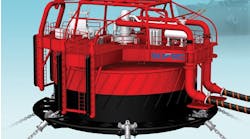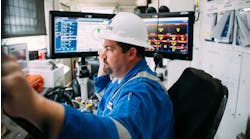Dan McLean
eProduction Solutions
Automation of oil and gas offshore facilities can conjure many opinions, from regulatory requirements to requirements for occasionally manned facilities, or from simple pneumatic controls to full electronic distributed control systems interfaced to many subsystems.
Seldom does the selection of the technology phase include looking at the complete business environment on a platform. Many aspects of operating an offshore platform require different systems. Because capital expenditure for a platform can be so high, the driver is only for completing the platform construction at the lowest cost. Many operators do not consider the life cycle of what is required during the front-end engineering design (FEED) stage to manage the asset from first oil to abandonment. This results in dissimilar systems being added over the life of a field.
null
At a minimum, three basic layers – process control, emergency shutdown systems, and fire and gas protection – are required to provide automation. The management of the reserves in place can be better achieved through advanced automation of the process control system.
Typically, process control systems deal only with the closed loop process control of well testing, separators, wellhead chokes, and miscellaneous systems, such as ballast controls. Seldom do they have the capability of well surveillance, workover scheduling, and production optimization. Additionally, they cannot accommodate the changes in the life cycle of the well after artificial lift becomes necessary, and they do not automatically calculate deliverability curves or estimate the cost benefit of potential workovers.
The enhanced automation technologies required to achieve the decision-making results include:
- Alternative to conventional measurement of production rates
- Control products with embedded applications
- Software applications, not just data collection
- Web-enabled applications.
Alternative to conventional
Recent advances in three-phase partial separation techniques have allowed operators to reap multiple benefits through immediate surveillance, quicker access to oil, water, and gas rates in near real time, and then using these data points to access real time controls for managing the wellheads. Process designs that include wellhead management solutions such as partial separation provide further benefits of less complicated valving schemes and less capital cost.
Various vendors are developing a wider range of applicable oil/ water/gas measurement ratio solutions that were previously discounted because operating conditions change over time.
Traditional well management using test separators is expensive, labor intensive, and slow. If one examines the overall cost benefit of individual partial separators versus conventional well test vessels, manifolds, piping, valves, and actuators, the capital cost is nearly the same, but the incremental benefit cannot be counted in conventional well testing.
The capital cost of individual partial separators will decrease as vendors compete for market space; however, because of the long-standing practice, the cost of conventional separators will not change. Less production, variations in flows translating into more instrumentation and controls downstream of the wellhead, and margins for measurement error will re-main operational issues with conventional well testing. More streamlined operations that get to the root of the problems quicker will be the overall benefit of automated wellhead management in the future. The key is to move the control closer to the source, i.e., the wellhead.
Embedded applications
The conventional approach to auto-mation design is to first select hardware based on either preferred vendor agreements or competitive price bidding. Then the process of preparing functional design specifications, soliciting process design information for configuration, factory acceptance testing, and commissioning the systems takes place. This usually requires multiple vendor/discipline interface points as no one interface has the entire solution.
Traditional practice generally includes process designers, automation designers, programmers, IT system architects, database analysts, graphical interface designers, and project management. The number of interface points amplifies the margins for error in the design process.
A better solution is to employ control products that already have the embedded solutions and combine them to software solutions that achieve the overall performance business objectives of the enterprise.
Software applications
In addition to improved wellhead operations, the entire workflow process of operating the well assets for the life of the well requires software applications that tightly integrate these functions. A lack of emphasis at the FEED stage of a platform design results in system integration issues as systems are added.
Ideally, one application optimizes the workflow process and identifies and improves daily operational efficiencies. Achieving this over the multiple disciplines in an E&P offshore operation is not easy. With the shrinking workforce of production engineers and reservoir analysts, combining the tools that each needs into automated solutions plus satisfying the day to day operations needs must be considered for the future.
Web-enabled applications
As the Internet becomes more accessible offshore, and corporate intranets become increasingly the primary interface for business deci- sion-making, Web-hosted solutions are becoming the norm. Mobile computing platforms with wireless capability grow more useful as applications and data are delivered to them. The concept of the well performance scorecard, embodying data retrieval, analysis, comparison, and automatic corrective action either through control or scheduling corrective action must be in place to achieve the benefits of the shareholders in shrinking workforce.
Control products that have embedded Web-enabled interfaces will make the system integration aspects easier and more standard in approach.
Improved automation
To manage the primary asset – the wells – it is necessary to employ many different software applications, coupled with the manual collection of data and the human interaction of data validation with tested results. The speed at which decisions can be made is entirely based on reliable and frequent measurement of production rates. Furthermore, the manner in which a well is produced changes during the life cycle of the well. The fundamental paradigm shift will be for achieving tighter control closer to the wellhead, rather than assuming a well is producing optimally while not on test.





